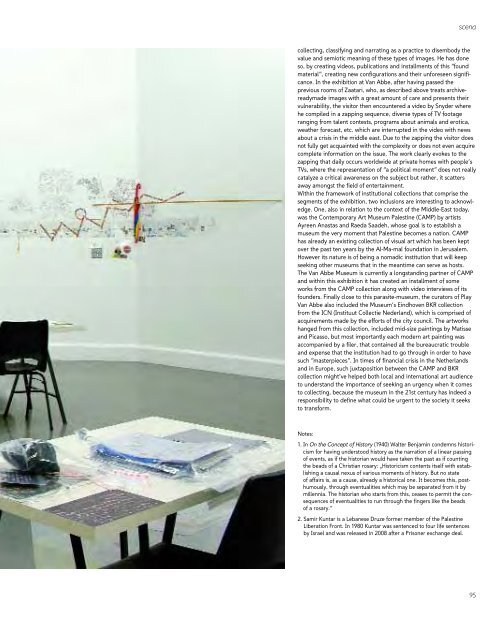You also want an ePaper? Increase the reach of your titles
YUMPU automatically turns print PDFs into web optimized ePapers that Google loves.
scena<br />
collecting, classifying and narrating as a practice to disembody the<br />
value and semiotic meaning of these types of images. He has done<br />
so, by creating videos, publications and installments of this “found<br />
material”, creating new configurations and their unforeseen significance.<br />
In the exhibition at Van Abbe, after having passed the<br />
previous rooms of Zaatari, who, as described above treats archivereadymade<br />
images with a great amount of care and presents their<br />
vulnerability, the visitor then encountered a video by Snyder where<br />
he compiled in a zapping sequence, diverse types of TV footage<br />
ranging from talent contests, programs about animals and erotica,<br />
weather forecast, etc. which are interrupted in the video with news<br />
about a crisis in the middle east. Due to the zapping the visitor does<br />
not fully get acquainted with the complexity or does not even acquire<br />
complete in<strong>format</strong>ion on the issue. The work clearly evokes to the<br />
zapping that daily occurs worldwide at private homes with people’s<br />
TVs, where the representation of “a political moment” does not really<br />
catalyze a critical awareness on the subject but rather, it scatters<br />
away amongst the field of entertainment.<br />
Within the framework of institutional collections that comprise the<br />
segments of the exhibition, two inclusions are interesting to acknowledge.<br />
One, also in relation to the context of the Middle-East today,<br />
was the Contemporary Art Museum Palestine (CAMP) by artists<br />
Ayreen Anastas and Raeda Saadeh, whose goal is to establish a<br />
museum the very moment that Palestine becomes a nation. CAMP<br />
has already an existing collection of visual art which has been kept<br />
over the past ten years by the Al-Ma-mal foundation in Jerusalem.<br />
However its nature is of being a nomadic institution that will keep<br />
seeking other museums that in the meantime can serve as hosts.<br />
The Van Abbe Museum is currently a longstanding partner of CAMP<br />
and within this exhibition it has created an installment of some<br />
works from the CAMP collection along with video interviews of its<br />
founders. Finally close to this parasite-museum, the curators of Play<br />
Van Abbe also included the Museum’s Eindhoven BKR collection<br />
from the ICN (Instituut Collectie Nederland), which is comprised of<br />
acquirements made by the efforts of the city council. The artworks<br />
hanged from this collection, included mid-size paintings by Matisse<br />
and Picasso, but most importantly each modern art painting was<br />
accompanied by a filer, that contained all the bureaucratic trouble<br />
and expense that the institution had to go through in order to have<br />
such “masterpieces”. In times of financial crisis in the Netherlands<br />
and in Europe, such juxtaposition between the CAMP and BKR<br />
collection might’ve helped both local and international art audience<br />
to understand the importance of seeking an urgency when it comes<br />
to collecting, because the museum in the 21st century has indeed a<br />
responsibility to define what could be urgent to the society it seeks<br />
to transform.<br />
Notes:<br />
1. In On the Concept of History (1940) Walter Benjamin condemns historicism<br />
for having understood history as the narration of a linear passing<br />
of events, as if the historian would have taken the past as if counting<br />
the beads of a Christian rosary: „Historicism contents itself with establishing<br />
a causal nexus of various moments of history. But no state<br />
of affairs is, as a cause, already a historical one. It becomes this, posthumously,<br />
through eventualities which may be separated from it by<br />
millennia. The historian who starts from this, ceases to permit the consequences<br />
of eventualities to run through the fingers like the beads<br />
of a rosary.“<br />
2. Samir Kuntar is a Lebanese Druze former member of the Palestine<br />
Liberation Front. In 1980 Kuntar was sentenced to four life sentences<br />
by Israel and was released in 2008 after a Prisoner exchange deal.<br />
95














